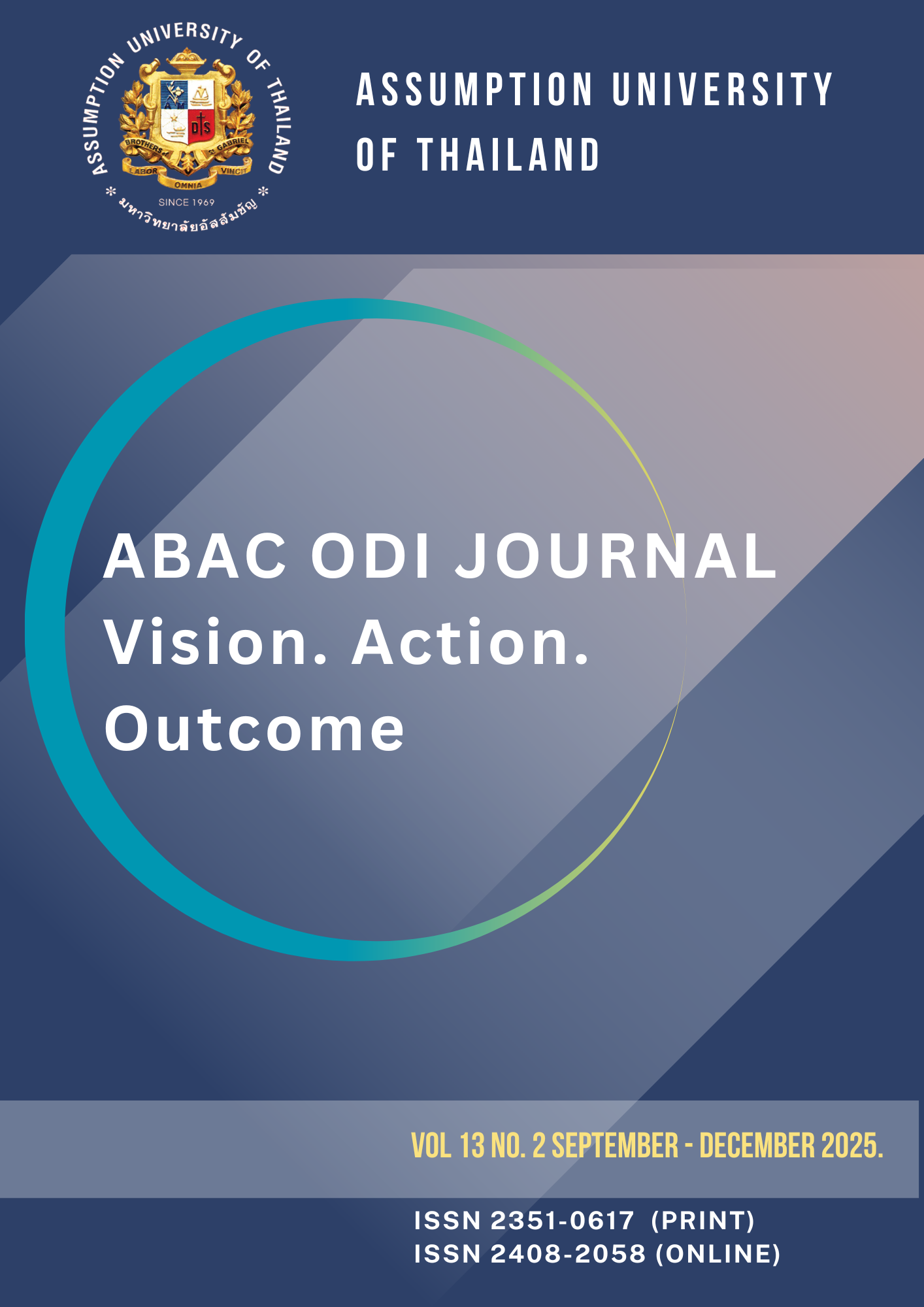Improving Team Effectiveness of College Student Association of Science and Technology Innovation at Zhanjiang University of Science and Technology in China
DOI:
https://doi.org/10.14456/abacodijournal.2025.54Abstract
This study aimed to explore pathways to enhance the team effectiveness of college student association and examine their impacts on student development. Focusing on the College Student Association of Science and Technology Innovation (CSASTI) at Zhanjiang University of Science and Technology (ZUST), the research employed Organizational Development Intervention (ODI) to improve communication, innovation, incentive, and leadership skills to enhance team effectiveness. A mixed-methods approach was adopted, combining questionnaire surveys and semi-structured interview, with a sample of 40 students participating in a three-month intervention. During the intervention, four targeted workshops were conducted, including the fishbowl conversation workshop for communication, the skills training workshop for innovation, the goal setting workshop for incentive, and the appreciative inquiry workshop for leadership skills. Data analysis revealed significant differences in all five variables before and after the ODIs, indicating that targeted ODI strategies could effectively improve team effectiveness. The findings suggest that by optimizing communication mechanisms, fostering innovative thinking, refining incentive systems, and strengthening leadership skills, the student association can not only increase operational team effectiveness but also better support student growth and development. This study provides practical insights and a feasible framework for improving the management of college student associations.
References
Abookire, S., Plover, C., Frasso, R., & Ku, B. (2020). Health design thinking: An innovative approach in public health to defining problems and finding solutions. Frontiers in Public Health, 8, 459. https://doi.org/10.3389/fpubh.2020.00459
Alzahrani, M. R., & Almohaimeed, M. (2025). A novel approach for estimation population mean with dual use of in stratified random sampling. Alexandria Engineering Journal, 119, 64-72. https://doi.org/10.1016/j.aej.2025.01.057
Amirianzadeh, M., Jaafari, P., Ghourchian, N., & Jowkar, B. (2011). Role of student associations in leadership development of engineering students. Procedia - Social and Behavioral Sciences, 30, 382-385. https://doi.org/10.1016/j.sbspro.2011.10.075
Anderson, N., Potočnik, K., & Zhou, J. (2014). Innovation and creativity in organizations: A state-of-the-science review, prospective commentary, and guiding framework. Journal of management, 40(5), 1297-1333. https://doi.org/10.1177/0149206314527128
Bellera, C. A., Julien, M., & Hanley, J. A. (2010). Normal approximations to the distributions of the Wilcoxon statistics: accurate to what N? graphical insights. Journal of Statistics Education, 18(2), 1. https://doi.org/10.1080/10691898.2010.11889486
Benjamin, R. H., Rita, B., & Felix, C. B. (2014). Does an adequate team climate for learning predict team effectiveness and innovation potential? A psychometric validation of the team climate questionnaire for learning in an organizational context. Procedia-Social and Behavioral Sciences, 114, 543-550. https://doi.org/10.1016/j.sbspro.2013.12.744
Bhat, S. K., Pande, N., & Ahuja, V. (2017). Virtual team effectiveness: An empirical study using SEM. Procedia Computer Science, 122, 33-41. https://doi.org/10.1016/j.procs.2017.11.338
Braun, V., & Clarke, V. (2019). Reflecting on reflexive thematic analysis. Qualitative Research in Sport, Exercise and Health, 11(4), 589-597. https://doi.org/10.1080/2159676X.2019.1628806
Buljac-Samardzic, M., Doekhie, K. D., & van Wijngaarden, J. D. (2020). Interventions to improve team effectiveness within health care: a systematic review of the past decade. Human resources for health, 18, 1-42. https://doi.org/10.1186/s12960-019-0411-3
Cerasoli, C. P., Nicklin, J. M., & Ford, M. T. (2014). Intrinsic motivation and extrinsic incentives jointly predict performance: A 40-year meta-analysis. Psychological Bulletin, 140(4), 980-1008. https://doi.org/10.1037/a0035661
Gneezy, U., Meier, S., & Rey-Biel, P. (2011). When and why incentives (don’t) work to modify behavior. Journal of economic perspectives, 25(4), 191-210. https://doi.org/10.1257/jep.25.4.191
Hussein, S. M., Daud, S. M., Mantoro, T., Shariff, S. A., & Hasan, M. M. (2018). Modelling team effectiveness and its determinants among multidisciplinary engineering students: A case of Malaysian Public University. International journal of engineering and technology, 7, 642-645. https://doi.org/10.14419/ijet.v7i2.29.13990
Kozlowski, S. W., & Ilgen, D. R. (2006). Enhancing the effectiveness of work groups and teams. Psychological Science in the Public Interest, 7(3), 77-124. https://doi.org/10.1111/j.1529-1006.2006.00030.x
Lewis, J. E. (2024). Team leadership curriculum development: A descriptive account of employing backward design in a cross-cultural setting. Studies in Learning and Teaching, 5(2), 525-532. https://doi.org/10.46627/silet.v5i2.428
Mathieu, J. E., & Gilson, L. L. (2012). Criteria issues and team effectiveness. The Oxford Handbook of Organizational Psychology, 910-930. https://doi.org/10.1093/oxfordhb/9780199928286.013.0027
Mathieu, J., Maynard, M. T., Rapp, T., & Gilson, L. (2008). Team effectiveness 1997-2007: A review of recent advancements and a glimpse into the future. Journal of Management, 34(3), 410-476. https://doi.org/10.1177/0149206308316061
Monks, L., & Mackay, S. (2024). Features of and barriers to effective teamwork at university and on clinical placement: The student radiographer perspective. Radiography, 30, 88-95. https://doi.org/10.1016/j.radi.2024.10.015
Mumford, M. D., Zaccaro, S. J., Harding, F. D., Jacobs, T. O., & Fleishman, E. A. (2000). Leadership skills for a changing world: Solving complex social problems. The leadership quarterly, 11(1), 11-35. https://doi.org/10.1016/S1048-9843(99)00041-7
Mumford, T. V., Campion, M. A., & Morgeson, F. P. (2007). The leadership skills strataplex: Leadership skill requirements across organizational levels. The leadership quarterly, 18(2), 154-166.https://doi:10.1016/j.leaqua.2007.01.005
Piña, M., Martínez, A., & Martínez, L. (2008). Teams in organizations: a review on team effectiveness. Team Performance Management, 14(1), 7-21. http://doi.org/10.1108/13527590810860177
Sachmpazidi, D., Olmstead, A., Thompson, A. N., Henderson, C., & Beach, A. (2021). Team-based instructional change in undergraduate STEM: characterizing effective faculty collaboration. International Journal of STEM Education, 8(1). https://doi.org/10.1186/s40594-021-00273-4
Stewart, R. E., Marcus, S. C., Hadley, T. R., Hepburn, B. M., & Mandell, D. S. (2018). State adoption of incentives to promote evidence-based practices in behavioral health systems. Psychiatric Services, 69(6), 685-688.
https://doi.org/10.1176/appi.ps.201700508
Thayer, A. L., Petruzzelli, A., & McClurg, C. E. (2018). Addressing the paradox of the team innovation process: A review and practical considerations. American Psychologist, 73(4), 363-375. https://doi.org/10.1037/amp0000310




